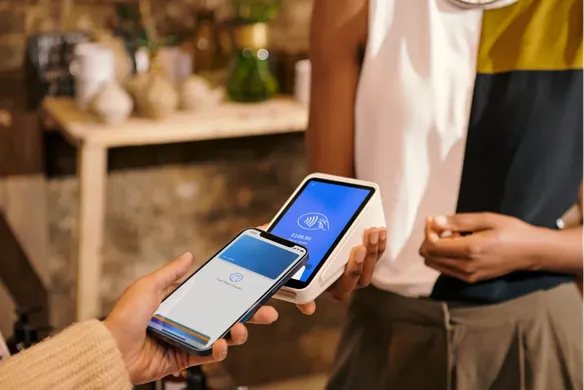Table of contents
There are plenty of examples of trendy slang and confusing buzzwords when it comes to payment systems, but contactless payment is one that’s worth paying attention to.
What is contactless payment exactly? It’s a quick payment made through your mobile device or contactless card – and the transaction method that makes the way you purchase things easier than ever.
Contactless payments — much like EMV payments — are also a lot more secure than payments via magnetic-stripe cards. Magstripe cards are extremely outdated (they’ve been around since the 1960s). The information associated with your bank account on a magstripe card is static (it’s right there on the stripe). So, if fraudsters get hold of your card, it’s relatively easy for them to lift and clone your data (and go on a shopping spree). With contactless payment, you don’t have to worry about that.
Here’s what you need to know about contactless payments, and why they’re so secure:
What is a contactless payment?
A contactless payment, as the name suggests, doesn’t require any physical contact between the buyer’s smartphone or credit card and the eftpos machine. You might also have heard the term NFC, which stands for “near field communication.” It’s the technology that powers contactless payments through a type of radio frequency identification (called RFID). NFC transactions take place over a specific radio frequency that enables the card or smartphone to communicate with the payment reader when they’re close together (usually 10 centimetres or less).
Contactless payment technology – a brief history
NFC is a type of radio frequency identification (or RFID) technology that allows us to identify things through radio waves. RFID is nothing new—it’s been used for decades for things like scanning items in grocery stores, luggage on baggage claims and tagging cattle. It’s now increasingly being used in video games and, more importantly, to enable contactless mobile payments.
What is a contactless payment card?
It’s rapidly becoming the standard for debit and credit cards have NFC technology that allows the customer to pay for items by tapping or passing their card above the payments reader. These types of cards are called contactless payments cards.
Why are contactless payments so secure?
It’s become the norm to use apps for everything from ordering takeout to booking a haircut, but as a consumer, you might be weary of using your phone to make purchases. Well, you shouldn’t be, and here’s why: Contactless payments are actually a lot more secure than magnetic-stripe or chip cards, whose incredibly outdated technology makes them relatively easy to clone. This means that you can end up the victim of fraudulent charges and identity theft. Contactless payments are authenticated payments, meaning they’re really hard to hack. In a contactless payment, the data associated with your credit card on file is encrypted and constantly changing. So even if fraudsters were to hack a system, the data they would find there would be useless.
What are different types of contactless payment?
Perhaps the most talked-about example of contactless payment is Apple Pay. It works on the iPhone 6, 6 Plus and the Apple Watch, which are all equipped with NFC technology. Starting with the iPhone 6, Apple’s fingerprint technology, Touch ID, means even if your phone is stolen, no one can access the credit cards stored in your app. To make a purchase with Apple Pay, just wait until the light on the payments reader turns on, and then hold your device up to it with your finger on the Touch ID button.
To enable Apple Pay at your store, you’ll need to invest in a contactless reader. The Square Reader accepts both Apple Pay and EMV cards.
Other types of contactless mobile payments
Google Pay
Google Pay is Google’s mobile wallet technology and one of the more popular NFC mobile payment apps. It is available on all NFC-enabled devices that run Android version 4.4 or later. To use Google Pay, customers just open the app on their phone (which requires the user to have a secure lock screen) and complete the transaction by holding their device over the payment reader.
Samsung Pay
Samsung Pay works on newer versions of Samsung Galaxy devices. Samsung Pay also works on NFC contactless readers. As opposed to Android Pay and Apple Pay, to trigger an NFC contactless payment with Samsung Pay, you swipe up from the home screen. As of version 2.5, Samsung Pay can also be used to pay for things in-app.
Magnetic Stripe Data (MSD) cards vs. Contactless EMV
Magnetic stripe cards are magnetised. When you swipe them, the payment processor reads the magnetic fields and matches them to your bank account information. However, this data is static, making it easier for fraudsters to lift bank information and clone it onto a new card.
On the other hand, the data on EMV chip cards is constantly changing, making it extremely hard to isolate and extract. To isolate and clone it, someone would have to get into the physical chip circuit and manipulate things to get your bank information. This is extremely difficult for even the most sophisticated fraudsters.
![]()











